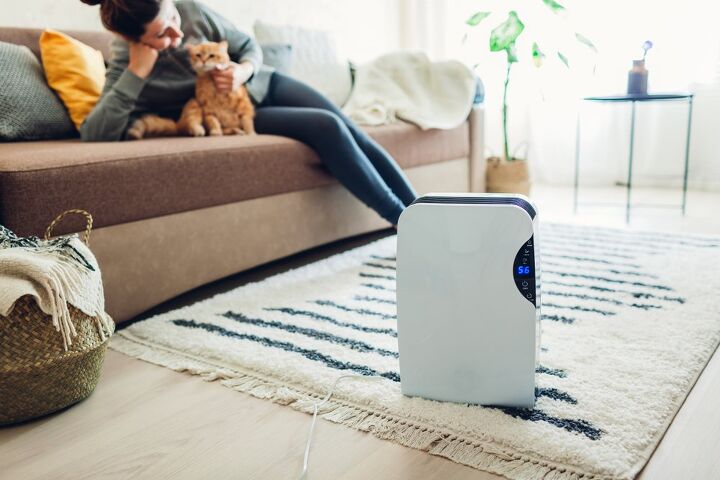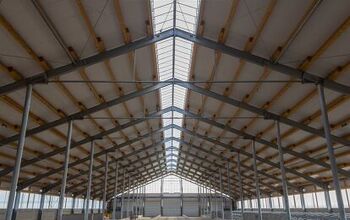DampRid Vs. Dehumidifier: Types & Common Uses

Whether it is the moldy smell or that feeling of stickiness in the air, humidity is annoying and can even be unhealthy. The choice of whether to use DampRid or a dehumidifier depends on what the situation is. It’s not a case of one being better than the other, but rather knowing when to use what product.
DampRid is ideal for small spaces like closets and bathrooms, and dehumidifiers are better for large rooms. Dehumidifiers are perfect for basements, but they lack the portability of the DampRid. DampRid is ideal if you plan to move it between small spaces, but dehumidifiers are better in terms of coverage and performance.
If you are just trying to keep that musty smell out of an RV, vacation home, or closet, a bucket or two of DampRid can do wonders. And you do not want to be running a dehumidifier in an empty building or structure. Running anything electrical in an empty home can cause a fire if left running alone. In this article, we’ll provide you with information you need to know about DampRid and Dehumidifiers and when it is best to use them.
Uses For DampRid And Dehumidifiers
Some of the best uses of DampRid include:
- Cabinets
- Closets
- Bathrooms
- Small rooms under 1,000 square feet
- Basements
- Cabins or vacation homes
- Unused rooms like an extra bedroom
- Boats
- Small RVs
The best places to use a dehumidifier include:
- Your home
- Vacation home
- Large RVs
- Any room larger than 1,000 square feet
All that being said, there are instances where you should not use either of these. Such as if you have a leak or a severe mold problem. These situations need to be handled first, by yourself or a professional. Otherwise, the dehumidifier or DampRid is just a temporary fix.
What Is DampRid?
A portable and disposable dehumidifier that comes in different sizes and styles, DampRid is easy to use, inexpensive and works well for small spaces. In fact, this is the cheapest way to dehumidify a small space and is safe to leave in an empty home or RV without worry.
Of course, there are always cons to every pro. Some of the disadvantages of using DampRid include:
- It does not work for a large room
- Has to be refilled with crystals or thrown away after a short amount of time
- Can be knocked over and spilled
- Bags can leak
- Buckets can also leak if cracked
- It is unattractive if left out in the open
What Is A Dehumidifier?
A dehumidifier is a device that removes and maintains the humidity levels in the air. There are many types of dehumidifiers, but the basic ones are rechargeable and electric. The cons of using a dehumidifier include:
- They are more expensive
- You have to empty them or use a drain hose
- You cannot leave them running in an empty home
- They take up more room than DampRid
Types of Dehumidifiers
The two main types of dehumidifiers include rechargeable and electric. Rechargeable dehumidifiers are filled with some type of absorbent gel that can be recharged in the oven or microwave. These can soak up to a quarter of their weight in water before needing to be recharged. They typically use silica gel that absorbs the moisture from the air. However, these are for small spaces like drawers, cabinets, and small closets.
The three main types of electric dehumidifiers are thermoelectric, compressor, and desiccant.
- Thermoelectric dehumidifiers (also known as Peltier or solid-state dehumidifiers) use a device that pumps heat from one side to the other, leaving the moisture at the bottom of the device. Warm moist air goes in the front, and the only thing that comes out on the other side is cool, dry air. The large ones can remove more than 20 ounces of water per day, while the smaller ones can remove four to 14 ounces a day.
- Compressor dehumidifiers are best for warmer rooms because the compressor coils can build up frost in a colder room. The room air is pulled in over the cold evaporator coil, and the water collects in a bucket or container below. These can typically remove about one gallon of moisture per day from the room. These are great for laundry rooms because they tend to be warm and moist.
- Desiccant dehumidifiers work by using a wheel made of zeolite that absorbs the moisture as it is drawn through it. They are great in unheated rooms as they work best when the temperature is below 60 degrees Fahrenheit. And as a bonus, they put out a nice flow of warm and dry air. It is also quieter and does not have that loud compressor sound.
- Heat pump dehumidifiers utilize a fan, heat pump, and heat exchange oils to collect moisture. The cold heat exchange coils help condense the humidity in the air to bring it to the proper level between 30% and 50%. They cost as little as $150, and heat pump dehumidifiers are user-friendly and reliable.
What Causes Humidity?
Many things can cause humidity in your home, RV, or any other enclosed space. Although we most often think of being outside in the heat when we think of humidity, it is often found to be high in your home as well.
Some of the things that cause humidity may surprise you and what’s worse is that there is nothing you can do to prevent it. For example, you cannot stop taking showers, doing laundry, or cleaning. Here are some of the causes of humidity in a home:
- Dishwashers. Dishwashers cause a lot of humidity, especially during the drying process when it sends the moisture out the vent into your home.
- Washing dishes by hand. Even washing dishes by hand increases the moisture factor in the house. Hot water running anywhere is humidity.
- Laundry is another significant cause of humidity. Of course, if your laundry room has a door or is in the basement, closing the door helps. But if you do not have some kind of dehumidifier in there, the humid air will eventually get out.
- Showering and bathing always increase humidity. Especially a hot shower. The hotter and more prolonged the shower, the more humidity. Use a fan to pull the moisture outside. If you don’t have one, they are not hard to install.
- Cooking. Cooking and heating food in the microwave or on the stove creates moisture too. Having a vent in the kitchen that sucks the moisture outside is excellent. Use the overhead fan on the oven.
- Breathing causes humidity as well. And since you cannot stop breathing, a humidifier would be helpful in this case.
Leaks And Humidity
If you are a plumber or a convenient DIYer, you need to fix the leak rather than just buying a dehumidifier or a few buckets of DampRid. Sure, you can toss a few buckets of DampRid in the basement, but if there is a small leak in the wall or floor, you are just temporarily covering the problem.
A leak of any kind, wherever it is, will eventually cause mold. Even if you clean it all up, dry it out, and put a massive dehumidifier in there, it will not fix the problem. The leak is just going to keep causing moisture, no matter how small it is. And eventually, you will end up with mold.
Humdity Helps Mold Grow
Mold can be a difficult situation, and it is best to get a professional to handle the problem. Unless you are trained in removing mold, you should at least talk to someone about how to deal with it.
Mold is a fungus, and it can be dangerous, especially for kids, pets, and people with breathing problems. Often, you cannot even see the mold. But if you have had any kind of leak or spillage, you can almost guarantee that there is some hidden mold somewhere.
Different Types Of Mold
There are different kinds of molds, but it can make you sick no matter which one you have. The mold spores get breathed into your lungs and cause asthma, bronchitis, and other lung illnesses. Toxic mold with mycotoxins can even cause death. That is why it is best to have a professional check it out.
To sum things up, you can use DampRid for small places or rooms less than 1,000 square feet. However, for anything larger than that, you should get a dehumidifier instead. And you should always find out and fix any leaks that can cause illness or worse.
Related Questions
Does DampRid reduce humidity?
Are dehumidifiers expensive to run?
Dehumidifiers are inexpensive to run, and they cost an average of $0.08 per hour to run. Homeowners spend an average of $1.92 per day to run a dehumidifier, but it can cost as little as $0.72 per day.
Is DampRid safe to breathe?
Should dehumidifiers run all the time?
You should not run a dehumidifier all the time, and you should shut it off if the humidity falls below 30%. Running your dehumidifier all the time can lead to bacteria, mold, and mildew. Run your dehumidifier as often as you need to keep the humidity between 30% and 50%.
Wrapping It Up
While DampRid is a dehumidifier, it works a bit differently than any old humidifier. Understanding the differences between DampRid and a dehumidifier will help you to choose what product you need for your particular circumstance. Regardless, if you have an indoor humidity problem, you will need to remove that excess moisture to prohibit mold growth in your living space.
Additionally, if it’s summer and you have a humidity problem, you can move your household plants outside. This will help keep your energy costs down, as well as the humidity level.

I am a DIYer who loves writing about anything home-related. When I am not writing, you can find me studying for my PhD in Psychology, photographing nature, and swimming at the lake with my grandkids.
More by Patricia Oelze















![10 Most Dangerous Neighborhoods in Baltimore [Updated]](https://cdn-fastly.upgradedhome.com/media/2023/07/31/9075655/10-most-dangerous-neighborhoods-in-baltimore-updated.jpg?size=350x220)











